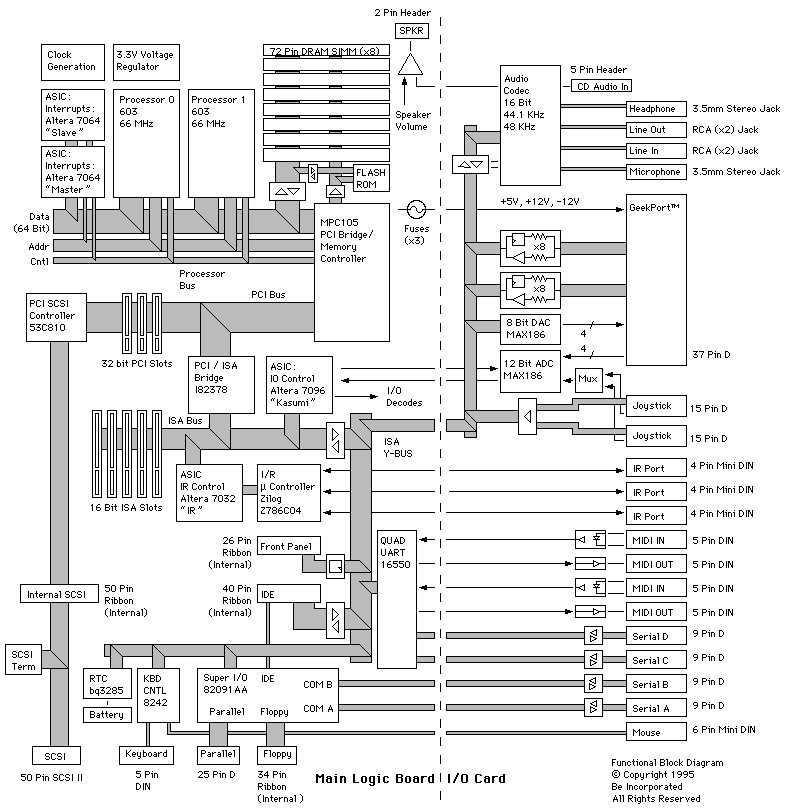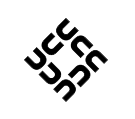|
⇤ ← Revision 1 as of 2018-05-14 14:27:48
Size: 5234
Comment:
|
Size: 5547
Comment: Add HW Block diagram, more details
|
| Deletions are marked like this. | Additions are marked like this. |
| Line 8: | Line 8: |
| Be Inc. was started in 1990 by Jean Louis Gasse, an early Apple pioneer. The company became defunct in 2001. For more information about the company, please see [[https://en.wikipedia.org/wiki/Be_Inc.|Be Inc.]] (Wikipedia). | Be Inc. was started in 1990 by Jean Louis Gasse, an early Apple pioneer. The company became defunct in 2001. For more information about the company, please see [[https://en.wikipedia.org/wiki/Be_Inc.|Be Inc.]] (Wikipedia). As of 2018, they are the last company to attempt to enter the home PC market with their own hardware and OS, and are considered an example not to follow. |
| Line 10: | Line 10: |
| These machines utilise dual PowerPPC 603/604e CPUs and were considered far ahead of their time. Be Inc developed their own operating system, intially only for PowerPC but was later ported to other platforms, which was called [[https://en.wikipedia.org/wiki/BeOS|BeOS]]. | These machines utilise dual PowerPPC 603 CPUs and were considered far ahead of their time. Be Inc developed their own operating system, intially only for PowerPC but was later ported to other platforms, which was called [[https://en.wikipedia.org/wiki/BeOS|BeOS]]. {{attachment:BeBox-HWBlockDiagW.gif}} |
| Line 27: | Line 29: |
| The two BeBoxen were donated sometime between 1995 and 1999 by past UCC member Peter N. Lewis, who was at the time a Mac developer and interested in trying the Be. | The two BeBoxen were donated sometime between 1995 and 1999 by past UCC member Peter N. Lewis, who was at the time a Mac developer and interested in trying the Be. As of 2018, he has given [[https://twitter.com/theducks/status/994740893314772993|permission for UCC to de-acession them]] |
BeBox (n; plural BeBoxen)
A Box manufatured by the company Be Inc.UCC has two BeBoxen, a revision 6 production model called magenta and a pre-release rev 5 prototype model which has no name and is missing the front panel. Magenta is stored in the cupboards upstairs in the loft and the rev5 BeBox is currently stored on the top shelf behind the door.
Be Inc. was started in 1990 by Jean Louis Gasse, an early Apple pioneer. The company became defunct in 2001. For more information about the company, please see Be Inc. (Wikipedia). As of 2018, they are the last company to attempt to enter the home PC market with their own hardware and OS, and are considered an example not to follow.
These machines utilise dual PowerPPC 603 CPUs and were considered far ahead of their time. Be Inc developed their own operating system, intially only for PowerPC but was later ported to other platforms, which was called BeOS.

The big problem they had was that they irritated their developers due to the brittle base class problem. They broke ABI a lot – even if your program would compile without changes, it still needed recompilation and redistribution to users. Pre-ubiquitous-fast-internet connections, that was ridiculously impractical. - Grahame Bowland, 1/04/2012
[...] Those guys were way ahead of their time. Database-based filesystems with indexing and searching; ubiquitous threading and multi-processor support; metadata mania; the whole works. It's only in the last few years that we've started to get the sorts of functionality they had back then. - Daniel Axtens, 31/03/2012
Pre-UCC history
The two BeBoxen were donated sometime between 1995 and 1999 by past UCC member Peter N. Lewis, who was at the time a Mac developer and interested in trying the Be. As of 2018, he has given permission for UCC to de-acession them
The rev5 prototype BeBox has one of the lowest serial numbers known (PPC95111000) according to a list of known BeBoxen (link not working as of 2018).
Only about 100 prototype BeBoxen were ever produced, handmade by Be Inc. employees and delivered to developers in 1995. They bore a label stating the following:
Attention! This device has not been approved by the Federal Communications Commission. This device is not, and may not be offered for sale or lease, or sold until the approval of the FCC has been obtained.
Only about 1800 BeBox units were ever sold. Magenta is one of the production units that were available to consumers after 1996.
UCC machine history
The revision 5 BeBox was installed a number of times shortly after its donation, however it died completely within hours of being powered on, which was taken to be an indication of a faulty motherboard. The second rev6 BeBox was successfully installed and was operational for a number of years.
During 1998 and 1999, inquiries were made by UCC members to repair the motherboard on the club's revision 5 BeBox, since the motherboard seemed cracked or otherwise faulty. In order to effect the repairs, the machine would have had to have been sent to the service center in California. Given its current state, it is unlikely that this ever happened.
Magenta was in regular use until about 2003 when it was presumably decommissioned and placed into storage in the clubroom / loft. It was pulled out again in 2007 set up as a display on O-Day. There are some nice photos here, courtesy of Alex Dawson.
Magenta was booted up again in 2012, after much difficulty resulting from one of the RAM modules being loose. A range of different video cards were tried in order to find one that could be used with the prototype machine, but this was unsuccessful. In order to connect the prototype to the network (in the case it was able to boot successfully), a DEC Tulip PCI or RTL8029 (or NE2000 compatible) PCI Ethernet card would have been required.
The machines are able to perform basic networking functions and authentication over LDAP. Due to the fact that BeOS failed to become widely used, there is very little software available that runs on it. At some point, there was a BeOS installer CD in the clubroom.
Hardware Notes
Magenta takes a standard AT keyboard and VGA monitor. The twin lines of vertically running LEDs on the front panel give an indication of the usage of the two CPUs.
BeBoxen are notoriously picky about video hardware. They will allegedly only work with the esoteric card they were shipped with.
BeBoxen take 72 pin 60ns RAM SIMMs
Future plans for the machine
Since these machines are likely non-functional and have very little use, they are of little value to the club except to be preserved as examples of an interesting period of computer history.
It is likely that the club will try to sell them in the near future to a computer museum or other interested parties. It is estimated that BeBox units are worth around $1500-$2500 per piece today.
Thanks to:
Thanks to James Cox, Andrew Williams, Alex Dawson, Andrew Adamson and Nick Bannon for contributing to this documentation of the history of these machines.



